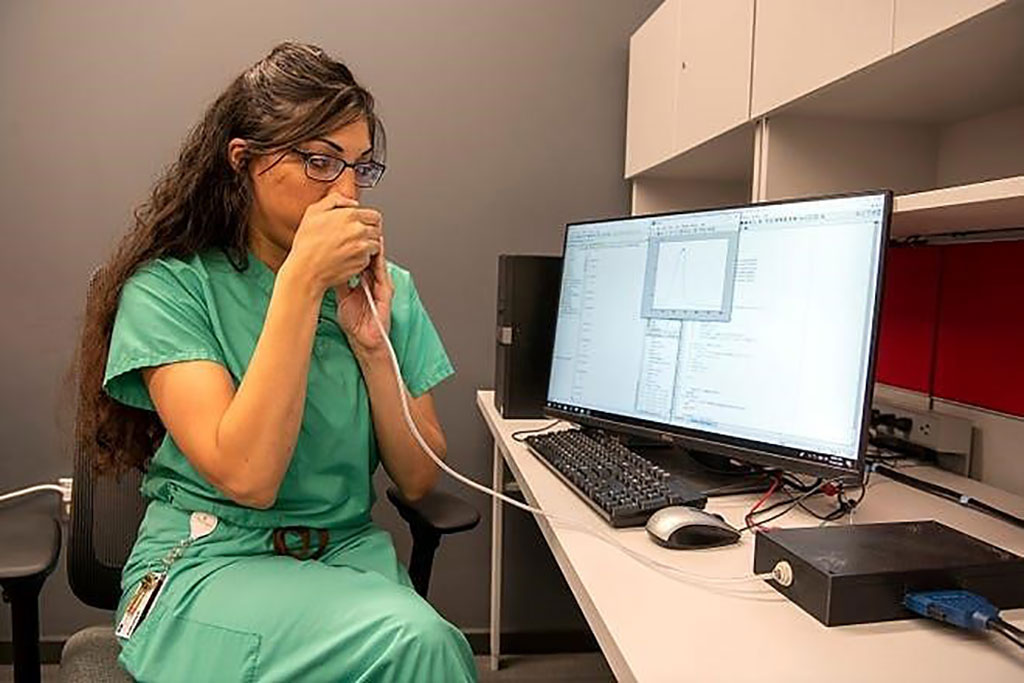Breath Test Can Identify COVID-19 in Critically Ill Patients
By LabMedica International staff writers
Posted on 17 Nov 2021
The coronaviruses known to infect humans generally only caused mild upper respiratory tract infectious symptoms. They are also known to delay the innate immune response to infection, and they have affinity for primary epithelial cells Posted on 17 Nov 2021
A common feature of respiratory viral infections is the release of inflammatory cytokines. These cytokines led to the production and release of volatile organic compounds (VOC), nitric oxide (NO), and ammonia (NH4). Novel breathalyzer technology utilizes a single selective, resistive chemosensor made of a catalytically active, semiconducting material, targeting NO and ammonia molecules in breath.

Image: Breath Test Can Identify COVID-19 in Critically Ill Patients and Asymptomatic Individuals (Photo courtesy of Ohio State University Wexner Medical Center)
Bioengineers and other scientists associated with the Ohio State University Wexner Medical Center (Columbus, OH, USA) have developed a COVID-19 breathalyzer which is an electronic device that uses a single catalytically active, resistive sensor that is highly selective to NO. The sensitivity of the γ-phase tungsten trioxide (WO3) sensor to NO, selectivity and response in the presence of various interfering compounds have been demonstrated before and are shown here for the specific conditions of this study, simulating human exhaled breath having various concentrations of NO and of the most abundant VOCs in breath: acetone, isoprene, and ammonia.
The team followed 46 patients who were admitted to the intensive care unit (ICU) with acute respiratory failure that required mechanical ventilation. Half of the patients had an active COVID-19 infection and the remaining half did not. All patients had a PCR COVID-19 test when they were admitted to the unit. The scientists collected samples from the exhalation port of the ventilator in 1-liter breath bags (Tedlar bags, CEL Scientific, Cerritos, CA, USA) from the patients on day 1, 3, 7, and 10 of their inpatient stay. The breath bag samples were tested within four hours of sample collection in a laboratory.
The investigators reported that the breathalyzer detected high exhaled nitric oxide (NO) concentration with a distinctive pattern for patients with active COVID-19 pneumonia. The COVID-19 “breath print” has the pattern of the small Greek letter omega (ω). The “breath print” identified patients with COVID-19 pneumonia with 88% accuracy upon their admission to the ICU. Furthermore, the sensitivity index of the breath print (which scales with the concentration of the key biomarker ammonia) appears to correlate with duration of COVID-19 infection. The negative predictive value of the breathalyzer was excellent at 90%.
Matthew C. Exline, MD, a Pulmonologist and senior author of the study, said, “The gold standard for diagnosis of COVID-19 is a polymerase chain reaction (PCR) test that requires an uncomfortable nasal swab and time in a laboratory to process the sample and obtain the results. The breathalyzer test used in our study can detect COVID-19 within 15 seconds.”
The authors concluded that the use of breathalyzer technology to rapidly diagnose patients with respiratory infections has the potential to greatly improve our ability to rapidly screen both patients and asymptomatic individuals. This study is the first to show the practical application of this emerging technology in a homogenous group of patients with a single infection. The study was published on October 28, 2021 in the journal PLOS ONE.
Related Links:
Ohio State University Wexner Medical Center
CEL Scientific













